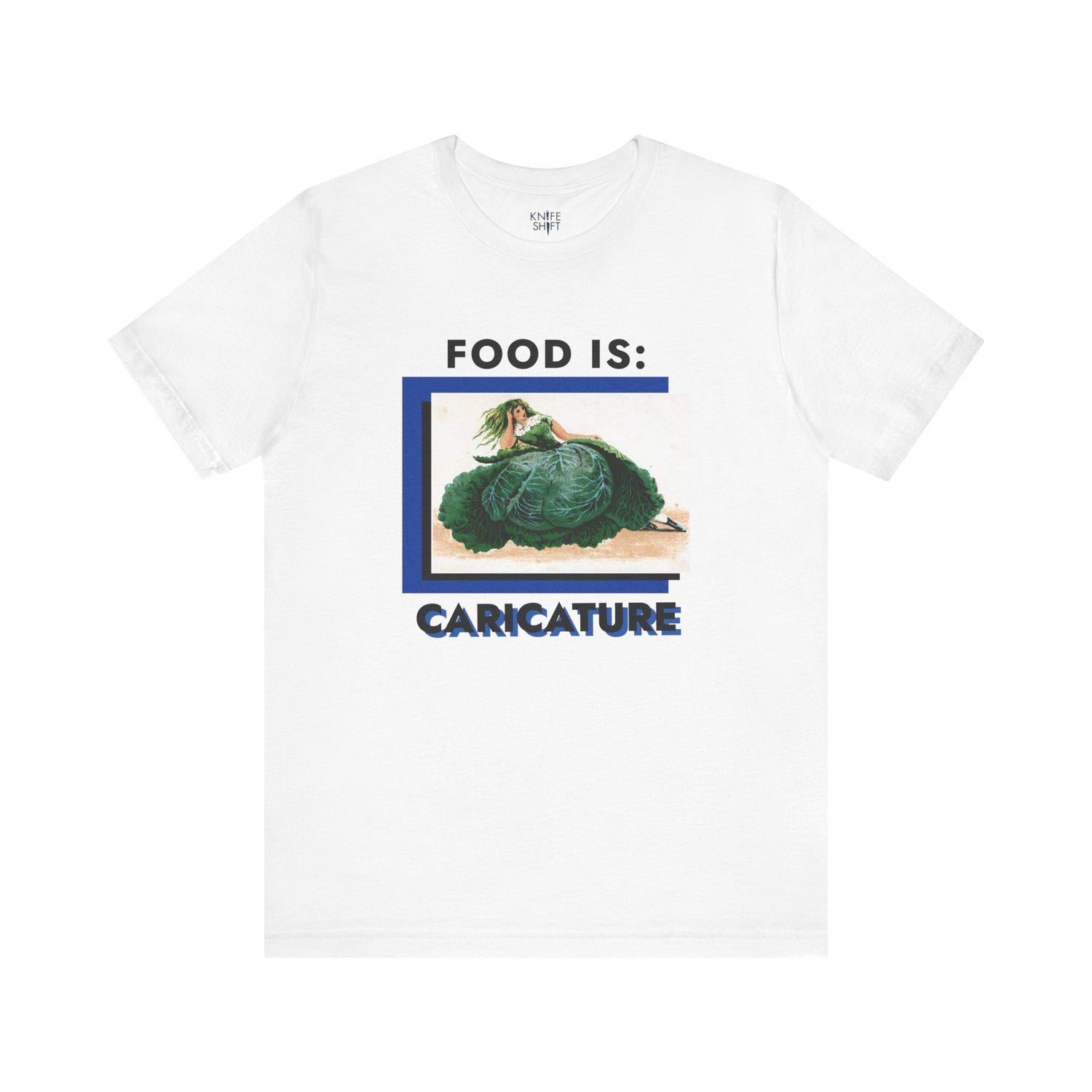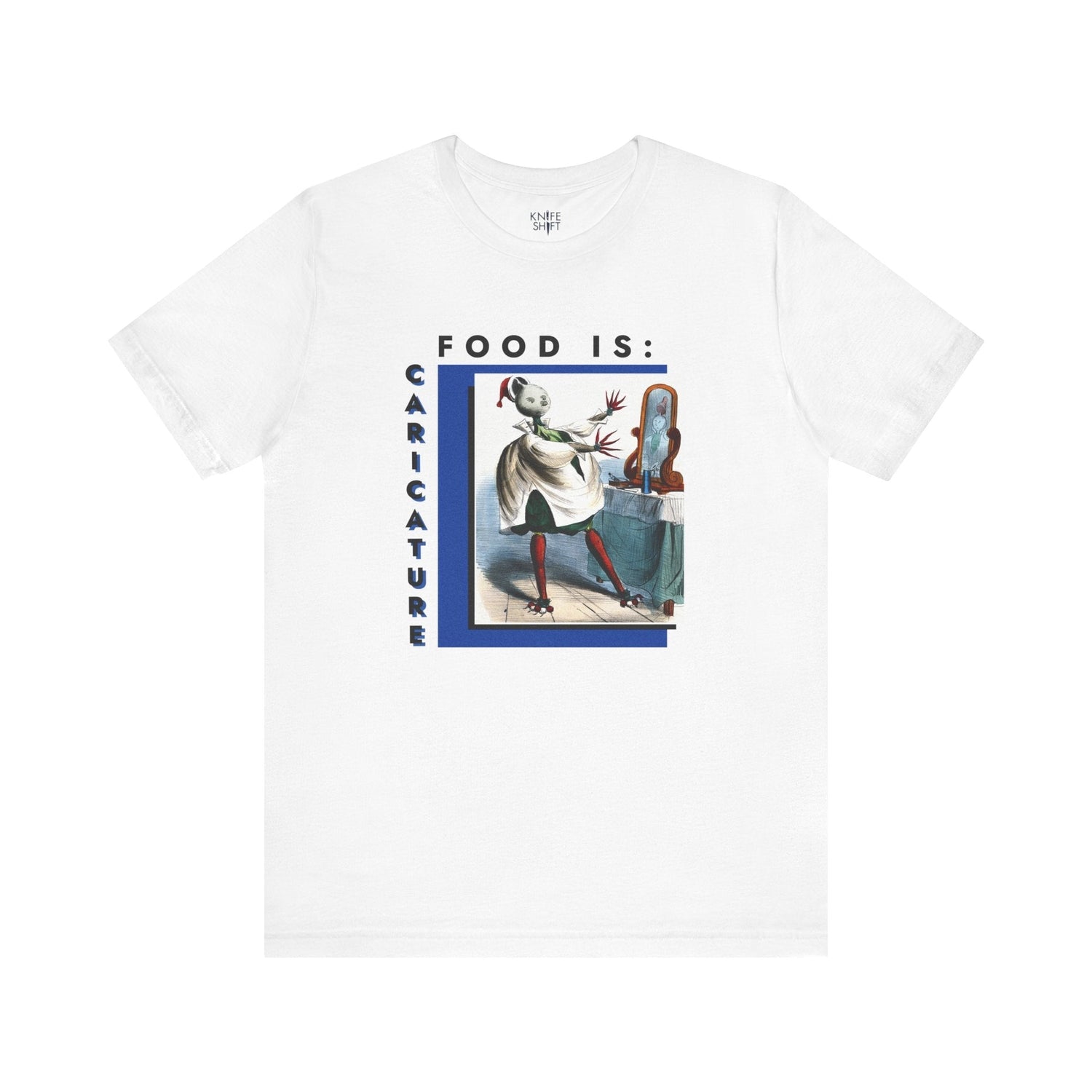Sort by:
About the Artwork:
This advertisement card printed in the United States in 1887 is a chromolithograph that features one man and two women with the bodies of red radishes. The image is meant to be humorous and eye-catching, and served as a calling card for Rice's Seeds to promote a variety of globe radishes.
Image courtesy of Boston Public Library via the Digital Commonwealth Collection.



Food is: Caricature | Unisex T-Shirt - Woman in Cabbage Dress
$34.99
Unit price perFood is: Caricature | Unisex T-Shirt - Woman in Cabbage Dress
$34.99
Unit price perAbout the Artwork:
The artwork pictured isn't attributed to a specific artist, but rather to the print shop Clay & Richmond, operating in Buffalo, New York during the mid to late 19th century. This company was known for producing quirky and often humorous chromolithographs, a type of colorful lithograph print.
The chromolithograph itself depicts a curious sight: a woman with an elegant posture leans confidently towards the viewer. Her unique gown, however, is the real showstopper. Instead of luxurious fabrics, she is adorned in a dress entirely fashioned from a single, vibrant green cabbage. The artist renders the ruffled leaves, creating an elegant ensemble.
Image courtesy of Boston Public Library via the Digital Commonwealth Collection.
About the Artwork:
Honoré Daumier, born in 1808 in Marseille, France, was a prolific and influential French artist known for his caricatures, paintings, and sculptures that keenly critiqued the social and political atmosphere of 19th-century France. Daumier's work, often published in periodicals such as La Caricature and Le Charivari, employed humor and satire to expose the follies and injustices of his time. His sharp wit and insightful portrayals have made him one of the most respected figures in the realm of political and social commentary through art.
This artwork is a lithograph that showcases Daumier’s unique blend of satire and visual narrative. "The king of pumpkins receiving the homage of his subjects" presents a scene where a large, round man and his partner survey various autumnal produce, including pumpkins. Daumier references pumpkins and the depiction of the large bodied people to create a scenario of a regal couple presiding over their subjects.
Image courtesy of the Met's Open Access Initiative.


Food is: Caricature | Unisex T-Shirt - Vegetable Pill Effects
$34.99
Unit price perFood is: Caricature | Unisex T-Shirt - Vegetable Pill Effects
$34.99
Unit price perAbout the Artwork:
This satirical print, titled "Wonderful Effects of Morrisons Vegetable Pills" and published by O'Hodgson in London, offers a humorous critique of 19th-century patent medicines. This was a period when unregulated "cure-alls," often with dubious ingredients, were widely advertised and consumed with promises of extraordinary results.
The image presents a chaotic scene. A figure, overwhelmed after consuming an excessive quantity of "Morrisons Vegetable Pills," gazes into a mirror. To their horror, their body has sprouted a bizarre profusion of vegetables: carrots, turnips, radishes, and various greens.
"Wonderful Effects of Morrisons Vegetable Pills" exaggerates the outlandish claims often made by patent medicine manufacturers. The sprouting vegetables mock the idea that a simple pill could bring about drastic physical transformation. The print cleverly exploits the connection between food and medicine to highlight the potential dangers of unregulated substances and the gullibility of the public.
Image courtesy of the National Library of Medicine Digital Collections.


Food is: Caricature | Unisex T-Shirt - Dapper Gentleman Carrot
$34.99
Unit price perFood is: Caricature | Unisex T-Shirt - Dapper Gentleman Carrot
$34.99
Unit price perAbout the Artwork:
While the specific artist behind the artwork on this advertisement card remains unknown, the print was produced by Clay & Richmond, a Buffalo, New York-based printing and publishing company that flourished in the mid-19th century. They were known for their quirky and often humorous chromolithographs, a type of colored print popular during that era.
This particular chromolithograph features a man's head, sporting a neatly trimmed beard and a serious expression, attached to the body of a plump carrot. The carrot figure is further adorned with a top hat and a monocle, the accessories of a sophisticated gentleman. The overall effect is comical while succeeding in capturing an air of elegance to the carrot gentleman.
Image courtesy of Boston Public Library via the Digital Commonwealth Collection.


Food is: Caricature | Unisex T-Shirt - Asparagus Ballet Dancer
$34.99
Unit price perFood is: Caricature | Unisex T-Shirt - Asparagus Ballet Dancer
$34.99
Unit price perAbout the Artwork:
Grégoire Caboche, an intriguing French artist of the 19th century, produced this artwork that illustrates a caricature of a performer from the Académie Royale de Musique, portrayed humorously as an asparagus in a vegetable-themed ballet. The painting captures her on stage, elegantly costumed in the likeness of the vegetable, complete with a slender, elongated bodice and a flared green skirt mimicking asparagus tips. The background suggests a theatrical setting with exaggerated and colorful props representing other vegetables, creating a lively and enchanting atmosphere.
Image courtesy of the New York Public Library's Digital Collections.
About the Artwork:
Amédéé Varin (active mid-19th century) was a French caricaturist known for his witty and often bizarre illustrations. While details about his life remain scarce, his surviving works offer a glimpse into the playful and satirical artistic circles of 19th-century France. Varin's "Carotte conjugale" ("Married Carrot") is a prime example, using a common vegetable to deliver a humorous and thought-provoking commentary on marital relations.
The artwork features a woman's face and torso forming into a carrot. She is garbed in the greens of the vegetable and embraces, presumably, her husband who is also depicted in vegetable form. The couple appears to be situated in a shared home on a sofa, with artwork of another vegetable persona hung on the wall behind them.
Image courtesy of the Minneapolis Institute of Art (Mia) under a CC-PDM license.
About the Artwork:
John Leech was an English caricaturist and illustrator, born in 1817 in London, known for his sharp wit and role in shaping British satirical art. Leech worked extensively for the magazine Punch, where he contributed drawings that highlighted the absurdities and contradictions within Victorian society. His work is celebrated for its humor, expressive characters, and ability to critique social norms while still engaging a broad audience. Leech’s illustrations not only entertained but also provided commentary on politics, culture, and everyday life, making him a key figure in the development of British cartoon and comic art.
"Vegetarian Odd Fellows" is an example of John Leech's humorous and satirical style, depicting two men as a carrot and parsnip. The man depicted as a parsnip appears to be elderly and is referred to by Leech as "Pa-Snip," potentially indicating a familial connection between the two figures or simply intending to highlight an age disparity. The other figure "Carrott" is aiding Pa-snip as the two engage in yard or farm labor.
Image courtesy of the Met's Open Access Initiative.
About the Artwork:
Amédée Varin, an artist active in the 19th century, was known for his imaginative and often whimsical illustrations that blended botanical elements with human characteristics. Varin's work typically involved elaborate depictions of plants and flowers anthropomorphized in a variety of scenes that both amused and fascinated viewers. His unique style captures an intersection of nature and human culture.
"Cucurbitus 1er/ Costume d'apparat" demonstrates Amédée Varin’s distinctive approach to botanical illustration. This artwork portrays a majestic figure, adorned in attire that mimics the form and texture of gourd vegetables. Varin’s meticulous attention to detail highlights the characteristics of the gourd, transforming them into a dignified presence that commands respect and curiosity.
Image courtesy of the Minneapolis Insitute of Art (Mia).










